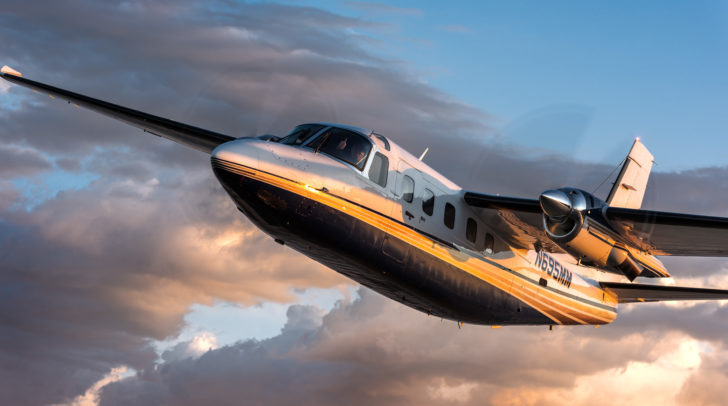By Matt Isley

I’m going to use the occasion of a fresh new year to do what people traditionally do at the beginning of a fresh new year, which is to prognosticate on the future, specifically as it applies to Twin Commanders. I’m going to do that by invoking a couple of seemingly contradictory clichés.
Here’s the first: The only constant is change. That’s certainly true of the Twin Commander line of turboprops. Change has been a central feature of Twin Commanders for decades, and change will continue to define the airplane. Twin Commanders flying today resemble the ones that rolled out of the Rockwell and, later, Gulfstream factory in Bethany, Oklahoma, in that the airframes are the same. Most everything else has undergone change.
Many of the TPE331-5-powered models are now powered by Dash 10T engines that deliver better takeoff, climb, and cruise performance. The plethora of mechanical and analog instruments, gauges, and avionics that filled the cockpit when the airplanes were produced have yielded to the most contemporary of all-electronic displays and instrumentation. Interior components and designs have evolved to keep pace with modern standards of comfort, reduced weight, and higher reliability, as have exterior paint schemes and finishes. Even the propellers are high-tech contemporary—the new five-blade composite MT props are lighter, quieter, and really raise the bar on ramp appeal.

Change is essential to the sustained appeal and value of Twin Commanders. Airplanes that don’t evolve to embrace state-of-the-art standards of technology, performance, reliability, weight, appearance, technical support and a host of other values are doomed to lag farther and farther behind the competition. Those that do ensure an active and productive future. Twin Commanders have changed with the times, and will continue to do so.
Now comes the second cliché, also appropriate for the times, and for Twin Commanders: The more things change, the more they stay the same. Sounds contradictory, but in fact it is an apt characterization. While Twin Commanders continue to evolve—to change—to meet the standards of today’s owners and pilots, the primary features that attract people to the airplane have not changed at all.
Some of those features are easily defined: performance, on two engines or one; the power and fuel efficiency of direct-drive Honeywell engines; a built-for-the-ages, highly corrosion-resistant airframe; ease of cabin entry; an unobstructed passenger view of the quickly passing earth below; a generously sized baggage compartment. Some are more subjective: “a pilot’s airplane” handling qualities and an imposing, low-slung ramp presence. And one is not so obvious on first look, but has great significance to owners: A stable worldwide authorized service center network that, in concert with Twin Commander Aircraft LLC, provides knowledgeable and experienced technical and sales support, readily available replacement parts, and upgrade options.
Kent Titcomb, the subject of the owner profile in this issue of Flight Levels, said it best when he articulated what he likes about his recently acquired Commander 840: “A blend of exceptional speed, exceptional fuel burn, reasonable purchase price, reasonable maintenance costs, cabin size, and payload/range flexibility. What machine can do more for less? Did I mention excellent short-field performance? Did I mention how good the aircraft flies? Ramp presence?”
Kent appreciates the enduring qualities of his Twin Commander, and he has plans, too, beginning with upgrading the panel with state-of-the-art avionics.
The Colombian Army obviously appreciates what Twin Commanders can do for its varied missions—Eagle Creek Aviation Services is completing the fifth Grand Renaissance conversion for the Colombians. A Grand Renaissance represents the highest expression of the successful marriage of constants and change as applied to a Twin Commander.
And, based on this issue’s Market Report, available inventory is down and prices are up for the most desirable Twin Commanders—those that offer the foundational features including performance, utility, reliability, and handling while incorporating the change exemplified by contemporary panels and modern interiors and paint.
So, for 2018 we will celebrate the past and all of the attributes designed and built into Twin Commanders that have made it an iconic brand, while encouraging the enhanced capability, versatility, and safety that constant change brings to the fleet.
Happy New Year!
